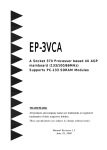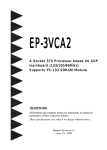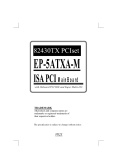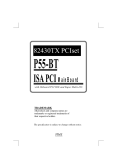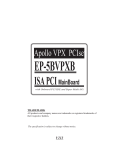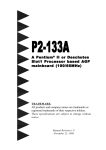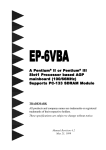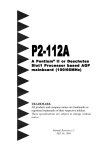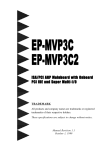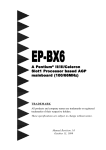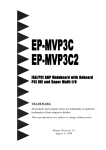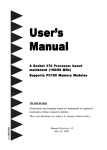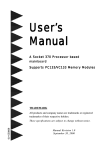Download EPOX EP-4BDM Specifications
Transcript
EP-MVP3G-M EP-MVP3G2 EP-MVP3G5 ISA/PCI/A GP Mainboar d with ISA/PCI/AGP Mainboard Onboar d PCI IDE and Super Onboard Multi-I/O TRADEMARK All products and company names are trademarks or registered trademarks of their respective holders. These specifications are subject to change without notice. Manual Revision 10.2 September 30, 1999 EP-MVP3G-M/2/5 User Notice No part of this product, including the product and software may be reproduced, transmitted, transcribed, stored in a retrieval system, or translated into any language in any form without the express written permission of EPoX Computer Company (hereinafter referred to as EPoX) except for documentation kept by the purchaser for backup purposes. We provide this manual “as is” without warranty of any kind, either expressed or implied, including but not limited to the implied warranties or conditions of merchantability or fitness for a particular purpose. In no event shall EPoX be liable for any loss of profits, loss of business, loss of use or data, interruption of business or for indirect, special incidental, or consequential damages of any kind, even if EPoX has been advised of the possibility of such damages arising from any defect or error in the manual or product. EPoX may revise this manual from time to time without notice. For updated BIOS, drivers, or product release information you may visit our websites at http://www.epox.com or http://www.epox.com.tw. Products mentioned in this manual are mentioned for identification purposes only. Product names appearing in this manual may or may not be registered trademarks or copyrights of their respective companies. The product name and revision number are both printed on the mainboard itself. Handling Procedures Static electricity can severely damage your equipment. Handle the EP-MVP3GM/2/5 and any other device in your system with extreme care and avoid unnecessary contact with system components on the mainboard. Always work on an antistatic surface to avoid possible damage to the mainboard from static discharge. Always have the power supply unplugged and powered off when inserting and removing devices within the computer chassis. EPoX assumes no responsibility for any damage to the EP-MVP3G-M/2/5 mainboard that results from failure to follow instruction or failure to observe safety precautions. CAUTION * The EP-MVP3G-M/2/5 mainboard is subject to damage by static electricity. Always observe the handling procedures. * We strongly recommend power source “OFF” while installation, or plug-in power cable or plug power supply into onboard power connector at last step. EP-MVP3G-M/2/5 Technical Support Services If you need additional information, help during installation or normal use of this product, please contact your retailer. Your retailer will have the most current information about your configuration. If your retailer cannot help, you may visit our online technical support website and/or contact our support technicians at the locations listed below. Record your serial number before installing your EP-MVP3G-M/2/5 mainboard. (The serial number is located near the PCI slots at the edge of the board.) EP-MVP3G-M/2/5 serial number: ______________________________ Contacting Technical Support EPoX technical support is working hard to answer all of your questions online. From our website you can find answers to many common questions, drivers, BIOS updates, tech notes, and important technical bulletins. If you are still unable to locate the solution you are seeking, you always have the option to contact our support technicians directly. North American website (English language) http://www.epox.com [email protected] [email protected] European website (Multi-language) http://www.epox.nl [email protected] [email protected] Taiwan website (Chinese language) http://www.epox.com.tw [email protected] [email protected] Thank you for using EPoX mainboards! Copyright 1999 EPoX Computer Company. All rights reserved. EP-MVP3G-M/2/5 Table of Contents Page Section 1 Introduction Components Checklist ..............................................1-1 Overview EP-MVP3G-M/2/5 Form-Factor .............................. 1-2 I/O Shield Connector ................................................1-3 Power-On/Off (Remote) .......................................... 1-3 System Block Diagram .............................................1-4 Section 2 Features EP-MVP3G-M/2/5 Features ....................................2-1 Section 3 Installation EP-MVP3G-M/2/5 Detailed Layout ........................3-2 Easy Installation Procedure Configure Jumpers ...................................................3-3 System Memory Configuration ................................ 3-5 Device Connectors ...................................................3-7 External Modem Ring-in Power ON and Keyboard Power ON Function (KBPO) .................. 3-9 Section 4 Award BIOS Setup BIOS Instructions .....................................................4-1 Standard CMOS Setup .............................................4-2 BIOS Features Setup ................................................4-3 Chipset Features Setup .............................................4-7 Power Management Setup ....................................... 4-10 PNP/PCI Configuration ........................................... 4-13 Integrated Peripherals ...............................................4-15 Load Setup Defaults ................................................. 4-19 Change Supervisor or User Password ...................... 4-20 IDE HDD Auto Detection ........................................4-21 EP-MVP3G-M/2/5 Save & Exit Setup .................................................... 4-23 Exit Without Saving ..................................................4-23 Appendix Appendix A Memory Map ...........................................................A-1 I/O Map ....................................................................A-1 Timer & DMA Channels Map ..................................A-2 Interrupt Map ...........................................................A-2 RTC & CMOS RAM Map .......................................A-3 Appendix B POST Codes ............................................................A-5 Unexpected Errors....................................................A-8 EP-MVP3G-M/2/5 Page Left Blank EP-MVP3G-M/2/5 Introduction Section 1 INTRODUCTION Components Checklist ü A. (1) One mainboard ü B. (1) One user’s manual ü C. (1) Floppy ribbon cable ü D. (1) IDE ribbon cable ATA-66 IDE ribbon cable (EP-MVP3G2/5 only) ü E. (1) PS/2 to AT keyboard connector adapter (optional) ü F. (1) (1) Ultra_DMA IDE driver diskette AGP Drivers USER’S MANUAL C EP-MVP3G-M/2/5 D B A E or F Page 1-1 Introduction EP-MVP3G-M/2/5 EP-MVP3G-M/2/5 Form Factor The EP-MVP3G-M/2/5 is designed with ATX form factor - the new industry standard of chassis. The ATX form factor is essentially a Baby-AT baseboard rotated 90 degrees within the chassis enclosure and a new mounting configuration for the power supply. With these changes the processor is relocated away from the expansion slots, allowing them all to hold full length add-in cards. ATX defines a double height aperture to the rear of the chassis which can be used to host a wide range of onboard I/O. Only the size and position of this aperture is defined, allowing PC manufacturers to add new I/O features (e.g.; TV input, TV output, joystick, modem, LAN, etc.) to systems. This will help systems integrators differentiate their products in the marketplace, and better meet your needs. • Smaller size promotes a smaller system size. • I/O shield does not need to be retooled in an ATX 2.01 or later. Mainboard could be used in an ATX 2.01-compliant. • A smaller power supply cam be used. High integration on mainboard reduces the system costs. Expandable I/O ATX Power Supply Single chassis fan for system CPU located near Power Supply Full length slots ATX power connector Floppy / IDE connectors close to peripheral bays Page 1-2 3 1/2" Bay 5 1/4" Bay Figure 2: Summary of ATX chassis features EP-MVP3G-M/2/5 Introduction I/O Shield Connector The EP-MVP3G-M/2/5 is equipped with an I/O back panel.Please use the appropriate I/O shield (figure 3). Parallel Port PS/2 Mouse PS/2 Keyboard USB COM1 COM2 Figure 3 Power-On/Off (Remote) The EP-MVP3G-M/2/5 has a single 20-pin connector for ATX power supplies. For ATX power supplies that support the Remote On/Off feature, this should be connected to the systems front panel for system Power On/Off button. The systems power On/Off button should be a momentary button that is normally open. The EP-MVP3G-M/2/5 has been designed with “Soft Off" functions. You can turn Off the system from one of two sources: The first is the front panel Power On/Off button, and the other is the "Soft Off" function (coming from the EPMVP3G-M/2/5’s onboard circuit controller) that can be controlled by the operating system. Windows 95/98 will control this when the user clicks that they are ready to Shutdown the system. ATX POWER SUPPLY J3 Case (chassis) Power ON/OFF button Figure 4: Simple ATX Power ON/OFF Controller Page 1-3 Introduction EP-MVP3G-M/2/5 System Block Diagram Figure 5: System Block Diagram Page 1-4 EP-MVP3G-M/2/5 Features Section 2 FEATURES EP-MVP3G-M/2/5 Features: • Intel Pentium® Processor, Pentium Processor with MMX technology, AMD K6/K6-2/K6 III, Cyrix 6x86MX/MII & idt C6/Winchip operating at 133 ~ 500 MHz with 321 ZIF socket 7 provides scalability to accept faster Processors in the future. • Supports ESDJ (Easy Setting Dual Jumper) function for CPU selection. • Designed with VIA MVP3 AGPset. • Supports up to 384 MB of DRAM (minimum of 16 MB) on board, You can use 168-pin DIMM x 3. (please see Section 3-2). • The EP-MVP3G-M/EP-MVP3G2 Supports 1MB L2 cache. The EP-MVP3G5 supports 2MB L2 cache. • Supports (2) 16 bit ISA slots, (5) 32 bit PCI slots, (1) AGP Slot and provides (2) independent high performance PCI IDE interfaces capable of supporting PIO Mode 3/4 and Ultra DMA 33/66 devices. The EP-MVP3G-M/2/5 supports (5) PCI Bus Master slots and a jumperless PCI INT# control scheme which reduces configuration confusion when plugging in PCI card(s). • Supports ATAPI (e.g. CD-ROM) devices on both Primary and Secondary IDE interfaces. • Designed with Integrated Multi I/O: (1) floppy port, (1) parallel port (EPP, ECP), and (2) serial ports (16550 Fast UART). Note: Japanese “Floppy 3 mode” is also supported • Features Award Plug & Play BIOS. With Flash Memory you can always upgrade to the current BIOS as they are released. (http://www.epox.com please visit our Technical Support section for the latest updates) • Includes a PS/2 mouse connector. Page 2-1 Features EP-MVP3G-M/2/5 • allows use of a PS/2 keyboard. • EP-MVP3G-M/2/5 utilizes a Lithium battery which provides environmental protection and longer battery life. • Built-in ATX 20-pin power supply connector. • Software power-down when using Windows® 95/98. • Supports ring-in feature (remote power-on through external modem, allows system to be turned on remotely). • Resume by Alarm - Allows your system to turn on at a preselected time. • Supports CPU Hardware sleep and SMM (System Management Mode). • Supports USDM software to offer motherboard various status. • Supports the CPU, PWR and Chassis fan Auto stop in sleep mode. • Supports the system Power LED (PANEL) blanks in the sleep mode. • Supports Keyboard Power ON function (KBPO). • Built-in WOL (Wake On Lan) Connector. • Built-in SB-LINK Header for Creative Labs Sound Blaster compatabile AWE64D PCI Sound Card. Page 2-2 EP-MVP3G-M/2/5 Installation Section 3 INSTALLATION Page 3-1 Installation EP-MVP3G-M/2/5 EP-MVP3G-M/2/5 Detailed Layout Figure 1 Page 3-2 EP-MVP3G-M/2/5 Installation Easy Installation Procedure The following must be completed before powering on your new system: 3-1. Configure Jumpers 3-2. System Memory Configuration 3-3. Device Connectors 3-4. External Modem Ring-in Power On and Keyboard Power On Function (KBPO) Section 3-1 Configure Jumpers We design this motherboard with the fewest jumpers to make your install fast and easy. Note: The jumpers as shown below are in their correct physical orientation. (Figure 1) JP1 CMOS Clear 1-2: Normal (Default) 2-3: Clear CMOS JP4 Keyboard Power-ON Function 1-2: Disabled (Default) 2-3: Enabled JP5 SDRAM Clock Selection 1-2: SDRAM = AGP (2/3 CPU Clock) 2-3: SDRAM = CPU (Default) Page 3-3 Installation EP-MVP3G-M/2/5 CPU Selection SW1 SW1 1 2 4 ON ON 1.8V ON ON ON 2.0V ON ON 5 ON 2.1V ON ON 2.2V ON 2.3V ON ON ON JP3 28 27 112MHz 100MHz 95MHz 83MHz 75MHz 66MHz 5.5X 5X 4.5X 4X 3.5X 3X 2.5X 2X Pentium/MMX AMD K6/K6-2/K6 III IDT-C6/Winchip 2.4V ON 2.8V ON 2.9V ON 3.2V JP3 Multiplier 166MHz 2.5X Cyrix/IBM 6x86MX/MII Bus Clock 66MHz PR200 75MHz PR233 83MHz PR266 95MHz PR300 250MHz 100MHz PR366 200MHZ 66MHz PR266 75MHz PR300 250MHz 83MHz PR333 95MHz *PR400 300MHz 100MHz *PR433 233MHz 66MHz 3X PR300 75MHz PR333 83MHz *PR400 333MHz 95MHz *PR466 350MHz 100MHz *PR500 266MHz 66MHz PR333 3.5X 2 1 ESDJ CPU Vcore 3 333MHz 4X 75MHz PR400 83MHz *PR466 380MHz 95MHz *PR533 400MHz 100MHz *PR550 300MHz 66MHz 450MHz 4.5X 333MHz 475MHz 66MHz 5X 500MHz 366MHz 100MHz 95MHz 100MHz 5.5X 66MHz * Reserved Page 3-4 EP-MVP3G-M/2/5 Installation Section 3-2 System Memory Configuration Memory Layout The EP-MVP3G-M/2/5 supports (3) 168-pin DIMMs (Dual In-line Memory Module). The DIMMs can be either EDO (Extended Data Out) or SDRAM (Synchronized DRAM). The DIMMs may be installed using just one chip. • DIMM SDRAM may be 83MHz (12ns), 100MHz (10ns) or 125MHz (8ns) bus speed. • If you use both 50ns and 60ns memory you must configure your BIOS to read 60ns. • When using Synchronous DRAM we recommend using the 4 clock variety over the 2 clock. Figure 2 and Table 1 show several possible memory configurations using both SIMM and DIMM. DIMM 1 B a nk 0/1 DIMM 2 B a nk 2/3 B a nk 4/5 DIMM 3 -S y nc hro n ou s -E D O Figure 2 Total Me mory DIMM 1 (Bank 0/1) DIMM 2 (Bank 2/3) DIMM 3 (Bank 4/5) = 128MB Maximum EDO/SDRAM* 8MB, 16MB, 32MB, None 64MB, 128MB X 1 None = 256MB Maximum EDO/SDRAM* EDO/SDRAM* 8MB, 16MB, 32MB, 8MB, 16MB, 32MB, 64MB, 64MB, 128MB X 1 128MB X 1 None = 384MB Maximum EDO/SDRAM* EDO/SDRAM* 8MB, 16MB, 32MB, 8MB, 16MB, 32MB, 64MB, 128MB X 1 64MB, 128MB X 1 EDO/SDRAM* 8MB, 16MB, 32MB, 64MB, 128MB X 1 Table 1 * SDRAM only supports 8, 16, 32, 64, 128MB DIMM modules. * We recommend to use PC100 Memory Module for bus speed between 66MHz and 100MHz. * Using non-compliant memory with higher bus speed (over clocking) may severely compromise the integrity of the system. Page 3-5 Installation EP-MVP3G-M/2/5 DIMM Module Installation Figure 3 displays the notch marks and what they should look like on your DIMM memory module. DIMMs have 168-pins and two notches that will match with the onboard DIMM socket. DIMM modules are installed by placing the chip firmly into the socket at a 90 degree angle and pressing straight down (figure 4) until it fits tightly into the DIMM socket (figure 5). LEFT KEY ZONE (UNBUFFERED) CENTER KEY ZONE (3.3 V DRAM) Figure 3 Figure 4 DIMM Module clip before installation Figure 5 DIMM Module clip after installation To remove the DIMM module simply press down both of the white clips on either side and the module will be released from the socket. Page 3-6 EP-MVP3G-M/2/5 Installation Section 3-3 Device Connectors Please install the motherboard into the chassis. Now that your motherboard is installed you are ready to connect all your connections (figure 6). Parallel Port PS/2 Mouse PS/2 Keyboard USB COM1 COM2 Figure 6 J2,J3: Chassis Panel Connector • Power_LED, Speaker, Reset, Power_ON/OFF, Turbo LED and HDD LED, IR Connector J4: CPU Fan Power • A plug-in for the CPU Fan Power J4: Power Fan Power • A plug-in for the Power supply Fan J6: Chassis Fan Power • A plug-in for the chassis Fan Power J7: WOL (Wake On Lan) Connector J8: SB_LIBK Connector IDE1: Primary IDE Connector IDE2: Secondary IDE Connector FDD1: Floppy Controller Connector PW1: ATX Power Connector • 20-pin power connector Page 3-7 Installation EP-MVP3G-M/2/5 Device Connectors (continued) (This is connected to the power button on the case. Using the SoftOff by Pwr-BTTN feature, you can choose either Instant Off (turns system off immediatly), or 4 sec delay (you need to hold the button down for 4 seconds before the system turns off). When the system is in 4 sec delay mode, there is a special feature to make the system to go into suspend mode when the button is pressed momentarily.) Power On/Off J3 1 Turbo LED indicator - LED ON when higher speed is selected + IDE LED indicator - LED ON when Onboard PCI IDE Hard disks is activate + IR Connector 1. VCC 2. NC 3. IRRX 4. GND 5. IRTX 1 J2 Power LED - Power LED connector 1. Power LED(+) 2. N/C 3. GND 4. NC 5. GND 1 Speaker - Connect to the system's speaker for beeping 1. Speaker 2. N/C 3. GND 4. GND 1 Reset - Closed to restart system. 1 Page 3-8 EP-MVP3G-M/2/5 Installation Section 3-4 External Modem Ring-in Power ON and Keyboard Power ON Functions (KBPO) On the basis of bounded functions in I/O chipset, the two serial ports are able to support the External Modem Ring-in Power ON function. Once users connect the external modem to COM1 or COM2, the EP-MVP3G-M/2/5 mainboard allows users to turn on their system through the remote and host's dial-up control. Exclusive Keyboard Power ON Function To innovate a unique feature to benefit users, we devoted the easiest and most convenient way to turn on your system based on the the ATX power supply. How to work with it Step 1: Please check JP4 at the position 1-2 after you finished the system installation. JP4 Keyboard Power-ON Function 1-2: Disabled (Default) 2-3: Enabled Step 2: You can enjoy the Keyboard Power ON function (KBPO) by pressing any 2 key and BUTTON only to turn on your system. Your system will be turned on automatically, after releasing the keys. To power off you system, you can use the Soft-OFF function under Windows 95. Notes: Intel ATX version 2.0 specification has recommended you use the power supply with 0.72A(720mA) in 5.0VSB. With our this mainboard, the 5.0VSB standby power only has to be > = 0.2A (200mA) then you can enjoy this unique benefit. However, the ATX power supply which is < 0.2 (200mA) is still applicable to your system by placed JP4 at the position 2-3 to disable this feature. Page 3-9 Installation EP-MVP3G-M/2/5 Page Left Blank Page 3-10 EP-MVP3G-M/2/5 BIOS Section 4 AWARD BIOS SETUP BIOS Instructions Award’s ROM BIOS provides a built-in Setup program which allows user to modify the basic system configuration and hardware parameters. The modified data will be stored in a battery-backed CMOS, so that data will be retained even when the power is turned off. In general, the information saved in the CMOS RAM will stay unchanged unless there is a configuration change in the system, such as hard drive replacement or a device is added. It is possible for the CMOS battery to fail, this will cause data loss in the CMOS only. If this does happen you will need to reconfigure your BIOS settings. To enter the Setup Program : Power on the computer and press the <Del> key immediately, this will bring you into the BIOS CMOS SETUP UTILITY. ROM PCI/ISA BIOS(2A5LEPAE) CMOS SETUP UTILITY AWARD SOFTWARE, INC. STANDARD CMOS SETUP SUPERVISOR PASSWORD BIOS FEATURES SETUP USER PASSWORD CHIPSET FEATURES SETUP IDE HDD AUTO DETECTION POWER MANAGEMENT SETUP SAVE & EXIT SETUP PNP/PCI CONFIGURATION EXIT WITHOUT SAVING INTEGRATED PERIPHERALS LOAD SETUP DEFAULTS ESC : QUIT : SELECT ITEM F10 : Save & Exit Setup (Shift)F2 : Change Color Time, Date, Hard Disk Type... Figure 4-1 CMOS SETUP UTILITY Page 4-1 BIOS EP-MVP3G-M/2/5 The menu displays all major selection items. Select the item you need to reconfigure. The selection is made by moving cursor (press any direction key ) to the item and press the 'Enter' key. An on-line help message is displayed at the bottom of the screen as the cursor is moving to various items which provides a better understanding of each function. When a selection is made, the menu of selected item will appear so the user can modify the associated configuration parameters. 4-1 STANDARD CMOS SETUP Choose "STANDARD CMOS SETUP" in the CMOS SETUP UTILITY Menu (Fig. 4-1). The STANDARD CMOS SETUP allows user to configure system setting such as the current date and time, type of hard disk installed, floppy type, and display type. Memory size is auto-detected by the BIOS and displayed for your reference. When a field is highlighted (use direction keys to move cursor and <Enter> key to select), the entries in the field will be changed by pressing <PgDn> or <PgUp> keys or user can enter new data directly from the keyboard. ROM PCI/ISA BIOS (2A5LEPAE) STANDARD CMOS SETUP AWARD SOFTWARE, INC. Date (mm:dd:yy) : Wed, Jan 15 1998 Time (hh:mm:ss) : 14 : 30 : 50 HARD DISKS Primary Master Primary Slave Secondary Master Secondary Slave TYPE : Auto : Auto : Auto : Auto SIZE 0 0 0 0 CYLS 0 0 0 0 Drive A : 1.44M,3.5 in. Drive B : None Floppy 3 mode Support : Disable Video : EGA/VGA Halt On : All, But keyboard ESC : Quit F1 : Help (Shift) F2 HEAD 0 0 0 0 PRECOMP 0 0 0 0 LANDZONE SECTORS MODE 0 0 Auto 0 0 Auto 0 0 Auto 0 0 Auto Base Memory : 640K Extended Memory : 31744K Other Memory : 384K Total Memory : 32768K : Select Item : Change Color PU/PD/+/- : Modify Figure 4-2 STANDARD CMOS SETUP Page 4-2 EP-MVP3G-M/2/5 BIOS Note: If the Primary Master/Slave and the Secondary Master/Slave are set as "Auto", the hard disk size and model will be auto-detected. Note: The "Halt On :" field is to determine when to halt the system by the BIOS if an error occurrs. 4-2 BIOS FEATURES SETUP By selecting the "BIOS FEATURES SETUP" option in the CMOS SETUP UTILITY menu, user can change system related parameters in the displayed menu. This menu shows all of the manufacturer's default values of this mainboard. Again, user can move the cursor by pressing direction keys and <PgDn> or <PgUp> keys to modify the parameters. Pressing [F1] key to display help message of the selected item. ROM PCI/ISA BIOS (2A5LEPAE) BIOS FEATURES SETUP AWARD SOFTWARE, INC. Virus Warning CPU Internal Cache External Cache Quick Power On Self Test Boot Sequence Swap Floppy Drive Boot Up Floppy Seek Boot Up NumLock Status Gate A20 Option Memory Parity/ECC Check Typematic Rate Setting Typematic Rate (Chars/Sec) Type matic Delay (Msec) Security Option PCI/VGA Palette Snoop OS Select For DRAM > 64MB HDD S.M.A.R.T. capability Report No FDD For WIN 95 : : : : : : : : : : : : : : : : : : Disabled Enabled Enabled Enabled A, C, SCSI Disabled Enabled On Fast Disabled Disabled 6 250 Setup Disabled Non-OS2 Disabled Yes Video BIOS C8000-CBFFF CC000-CFFFF D0000-D3FFF D4000-D7FFF D8000-DBFFF DC000-DFFFF Shadow Shadow Shadow Shadow Shadow Shadow Shadow Esc : Quit F1 : Help F5 : Old Values F7 : Load Setup Defaults : : : : : : : Enabled Disabled Disabled Disabled Disabled Disabled Disabled : Select Item PU/PD/+/- : Modify (Shift)F2 : Color Figure 4-3 BIOS FEATURES SETUP Virus Warning: This category flashes on the screen. During and after the system boots up, any attempt to write to the boot sector or partition table of the hard disk drive will halt the system and an error message will appear. You should then run an anti-virus program to locate the virus. Keep in mind that this feature protects only the boot sector, not the entire hard drive. Default value is Disabled. Page 4-3 BIOS EP-MVP3G-M/2/5 Enabled : Activates automatically when the system boots up causing a warning message to appear when any attempt to access the boot sector or hard disk partition table. Disabled :No warning message to appear when any attempt to access the boot sector or hard disk partition table. CPU Internal Cache / External Cache: These two categories speed up memory access. However, it depends on CPU/chipset design. The default value is Enabled. If your CPU is without Internal Cache then this item "CPU Internal Cache" will not be shown. Enabled : Enable cache. Disabled : Disable cache. Quick Power On Self Test:This category speeds up Power On Self Test (POST) after you power on the computer. If it is set to Enable, BIOS will shorten or skip some checking items during POST. Enabled : Enable quick POST. Disabled: Normal POST. Boot Sequence:This category determines which drive is searched first for the O/S(Operating System).The default value is A,C. A,C : The system will search for floppy disk drive first then hard disk drive. C,A : The system will search for hard disk drive first then floppy disk drive. Swap Floppy Drive: This will swap your physical drive letters A&B if you are using two floppy disks. The default value is Disabled. Enabled : Floppy A & B will be swapped under the O/S. Disabled : Floppy A & B will be not swapped. Boot Up Floppy Seek: During Power-On-Self-Test (POST), BIOS will determine if the installed floppy drive is 40 or 80 tracks. Only 360K type is 40 tracks while 760K, 1.2M and 1.44M are all 80 tracks. The default value is Enabled. Enabled : BIOS searches for floppy disk drive to determine if it is 40 or 80 tracks. Note that BIOS cannot tell from 720K, 1.2M or 1.44M drive type as they are all 80 tracks. Disabled: BIOS will not search for the type of floppy disk drive by track number. Page 4-4 EP-MVP3G-M/2/5 BIOS Note that there will not be any warning message if the drive installed is 360K. Boot Up NumLock Status: The default value is On. On : Keypad is number keys. Off : Keypad is arrow keys. Gate A20 Option: This refers to the way the system addresses memory above 1MB (extended memory). The default value is Fast. Normal: The A20 signal is controlled by keyboard controller or chipset hardware. Fast : The A20 signal is controlled by Port 92 or chipset specific method. Typematic Rate Setting: This determines the typematic rate. Enabled : Enable typematic rate and typematic delay programming. Disabled: Disable typematic rate and typematic delay programming. The system BIOS will use default value of 2 items and the default is controlled by the keyboard. Typematic Rate(Chars/Sec): This is the number of characters that will be repeated by a keyboard press. The default is 6. 6 : 6 characters per second. 8 : 8 characters per second. 10: 10 characters per second. 12: 12 characters per second. 15: 15 characters per second. 20: 20 characters per second. 24: 24 characters per second. 30: 30 characters per second. Typematic Delay(Msec): This determines the time between the first and second character displayed, when holding a key. The default is 250. 250 : 250msec. 500 : 500 msec. 750 : 750 msec. 1000: 1000 msec. Security Option: This category allows you to limit access to the system and Setup, or just to Setup. The default value is Setup. System: The system will not boot and the access to Setup will be denied if the correct password is not entered at the prompt. Setup : The system will boot, but the access to Setup will be denied if the correct password is not entered at the prompt. Page 4-5 BIOS EP-MVP3G-M/2/5 PCI/VGA Palette Snoop: This filed controls the ability of a primary PCI VGA controller to share a common palette (when a snoop write cycles) with an ISA video card. The default value is Disabled. Enabled: If an ISA card connects to a PCI VGA card via the VESA connector and the ISA card connects to VGA monitor and uses the RAMDAC of PCI card, the PCI/VGA Palette Snoop is enabled. Disabled: Disable the VGA card Palette snoop function. OS Select For DRAM > 64MB: Some operating systems require special handling. Use this option only if your system has greater than 64MB of memory. The default is Non-OS2. OS2: Select this if you are running the OS/2 operating system with greater than 64MB of RAM. Non-OS2:Select this for all other operating systems and configurations. HDD S.M.A.R.T capability: Enabled SMART hard drive functions for compatible hardware. The default is Disabled. Enabled: S.M.A.R.T features are available. Disabled: S.M.A.R.T features will no be available. Report No FDD For WIN95: This option allows BIOS to indicate whether WIN95 is with FDD or not. The Default value is Yes. NO: Report No FDD for WIN95. YES: Report FDD for WIN95 Video BIOS Shadow: It determines whether video BIOS will be copied to RAM. However, it is optional from chipset design. Video Shadow will increase the video speed. Enabled : Video shadow is enabled. Disabled: Video shadow is disabled. C8000 CC000 D0000 D4000 D8000 DC000 Page 4-6 CBFFF CFFFF D3FFF D7FFF DBFFF DFFFF Shadow : Shadow: Shadow: Shadow: Shadow: Shadow: EP-MVP3G-M/2/5 BIOS These categories determine whether optional ROM will be copied to RAM by 16K byte or 32K byte per unit and the size depends on the chipset. Enabled : Optional shadow is enabled. Disabled: Optional shadow is disabled. 4-3 CHIPSET FEATURES SETUP Choose the "CHIPSET FEATURES SETUP" in the CMOS SETUP UTILITY menu to display the following menu. ROM PCI/ISA BIOS (2A5LEPAE) CHIPSET FEATURES SETUP AWARD SOFTWARE, INC. Bank 0/1 DRAM Timing Bank 2/3 DRAM Timing Bank 4/5 DRAM Timing SDRAM Cycle Length SDRAM Bank Interleave DRAM Page-Mode DRAM Read Pipeline DRAM Fast Decoding Sustained 3T Write Cache Rd+CPU Wt Pipeline Cache Timing Linear Burst Video BIOS Cacheable System BIOS Cacheable Memory Hole AT 15Mb Addr. AGP Aperture Size Cyrix M2 ADS# delay Fan In Suspend : FP/EDO Fast : FP/EDO Fast : FP/EDO Fast :3 : Disabled : Enabled : Enabled : Auto : Enabled : Enabled : Fast : Disabled : Enabled : Disabled : Disabled : 64M : Disabled : Off Auto Detect DIMM/PCI Clk : Enabled Spread Spectrum : Disabled CPU Host Clock (CPU/PCI) : Default CPU Warning Temperature : 60OC/140OC Shutdown Temperature : 70OC/158OC Current CPU Temperature : 37OC/98 OC Current System Temperature. : 25OC/77 OC Current CPU FAN Speed : 0 RPM Current CHASSIS FAN Speed : 0 RPM Current POWER FAN Speed : 0 RPM CPUcore : 2.20V CPUI/O : 3.52V +5V : 4.99V +12V : 12.09V -12V : -12.04V -5V : -5.12V Esc : Quit F1 : Help F5 : Old Values F7 : Load Setup Defaults : Select Item PU/PD/+/- : Modify (Shift)F2 : Color Figure 4-4 CHIPSET FEATURES SETUP Page 4-7 BIOS EP-MVP3G-M/2/5 Bank 0/1, 2/3, 4/5 DRAM Timing: This value in this field is set by the system board manufacturer, depending on whether the board has paged DRAMs or EDO (extended data output) DRAMs. The Choice: Bank 0/1, 2/3, 4/5. SDRAM Cycle length: This setting defines the CAS timing parameter of the SDRAM in terms of clocks. The default is 3. 2: Provides faster memory performance. 3: Provides better memory compatibility. SDRAM Bank Interleave: The default value is Disabled. Disabled : Normal Setting. 2 Bank/4 Bank: SDRAM 2 or 4 Bank Interleave. DRAM Page-Mode: The item will active or inactive chipset page registers. Enabled: Page-Mode Enabled. Disabled: No page registers update and non Page-Mode operation. DRAM Fast Decoding: The item will effective DRAM operation sequential. Video BIOS Cacheable: This option copies the video ROM BIOS to fast RAM (C0000h to C7FFFh). The default is Enabled. Enabled: Enables the Video BIOS Cacheable to speed up the VGA Performance. Disabled: Will not use the Video BIOS Cacheable function. System BIOS Cacheable: This allows you to copy your BIOS code from slow ROM to fast RAM. The default is Disabled. Enabled: The option will improve system performance. However, if any program writes to this memory area, a system error may result. Disabled: System BIOS non-cacheable. Memory Hole at 15M-16M Addr.: The default value is Disabled. Disabled: Normal Setting. Enabled : This field enableds the main memory (15~16MB) remap to ISA BUS. AGP Aperture Size: The amount of the system memory that the AGP card is allowed to share. The options available are 4M, 8M, 16M, 32M, 64M, 128M, 256M. The default value is 64M. Page 4-8 EP-MVP3G-M/2/5 BIOS Auto Detect DIMM/PCI Clk: Allows you to stop DIMM/PCI Clock drive when the DIMM site or PCI Slot are not plug. This item may help reduce EMI. The default is Enabled. Enabled: Provides unused DIMM/PCI to stop. Disabled: Provides the clock generator always driving. Spread Spectrum : Allows you to active the Spread Spectrum Modulation function for reduce EMI. (Note: When Enabled the item that performance will be impacted). The default is Disabled. Enabled: Provides the Spread Spectrum function from clock generator. Disabled: NO Spread Spectrum function. CPU Host Clock (CPU/PCI): Allows the external clock to be modified depending upon what FSB has been selected. Should not be used to clock processor faster than it was designed for. The default is Default. 66MHz FSB options: Default, 66.6, 75, and 83.3MHz. 100MHz FSB options: Default, 95, 100, 112, 124, and 133MHz. CPU Warning Temperature: The default value is Disabled Disabled : Normal Setting. Enabled: The options available is 50C/122F~70C/158F. Current System Temperature: This is the current temperature of the system. Current CPU Temperature: This is the current temperature of the CPU. Current CPU Fan Speed: The current CPU fan speed in RPMs. Current CHASSIS FAN Speed: The current chassis fan speed in RPMs . Current POWER FAN Speed: The current power fan speed in RPMs . CPU(V) : The voltage level of the CPU(Vio/Vcore). +5V, +12V: The voltage level of the power supply. Page 4-9 BIOS EP-MVP3G-M/2/5 4-4 POWER MANAGEMENT SETUP Choose the "POWER MANAGEMENT SETUP" in the CMOS SETUP UTILITY to display the following screen. This menu allows the user to modify the power management parameters and IRQ signals. In general, these parameters should not be changed unless it is absolutely necessary. ROM PCI/ISA BIOS (2A5LEPAE) POWER MANAGEMENT SETUP AWARD SOFTWARE, INC. ACPI function Power Management PM Control by APM Video off Option Video off Method MODEM Use IRQ Soft-off by PWRBTN **PM Timers ** HDD Power Down Doze Mode Suspend Mode ** PM Events ** VGA LPT & COM HDD & FDD DMA /master Modem Ring Resume RTC Alarm Resume : : : : : : : Enabled User Define Yes Suspend -> Off V/H SYNC+Blank 3 Delay 4 Sec : Disable : Disable : Disable : : : : : : OFF LPT /COM ON OFF Disabled Disabled Primary INTR IRQ3 IRQ4 IRQ5 IRQ6 IRQ7 IRQ8 IRQ9 IRQ10 IRQ11 IRQ12 IRQ13 IRQ14 IRQ15 (COM 2) (COM 1) (LPT 2) (Floppy Disk) (LPT 1) (RTC Alarm) (IRQ2 Redir) (Reserved) (Reserved) (PS/2 Mouse) (Coprocessor) (Hard Disk) (Reserved) : ON : Primary : Primary : Primary : Disabled : Primary : Disabled : Secondary : Secondary : Secondary : Primary : Primary : Primary : Disabled Esc : Quit : Select Item F1 : Help PU/PD/+/- : Modify F5 : Old Values (Shift)F2 : Color F7 : Load Setup Defaults Figure 4-5 POWER MANAGEMENT SETUP ACPI function: Use this to enable or disable ACPI power management functions. The default is enabled. Enabled: Enabled ACPI power management functions. Disabled: Disabled ACPI power management functions. You can only change the content of Doze Mode, Standby Mode, and Suspend Mode when the Power Management is set to 'User Define'. Power Management: Use this to select your Power Management selection. The default is User define. Disabled: The system operates in NORMAL conditions (Non-GREEN), and the Power Management function is disabled. Max. saving: Maximum power savings. Inactivity period is 1 minute in each mode. Page 4-10 EP-MVP3G-M/2/5 BIOS Min. saving: Minimum power savings. Inactivity period is 1 hour in each mode. User define: Allows user to define PM Timers parameters to control power saving mode. PM controlled APM: This option shows weather or not you want the Power Management to be controlled the Advanced Power Management (APM). The default is Yes. Yes: APM controls your PM No: APM does not control your PM Video Off option: Tells you what time frame that the video will be disabled under current power management settings. The default is Suspend -> Off. Standby: Video powers off after time shown in standby mode setting. Doze: Video powers off after time shown in doze mode setting. Suspend: Video powers off after time shown in suspend mode setting. N/A: Video power off not controlled by power management. Video Off Method: This option allows you to select how the video will be disabled by the power management. The default is V/H Sync + Blank V/H Sync + Blank: System turns off vertical and horizontal synchronization ports and writes blanks to the video buffer. DPMS: Select this option if your monitor supports the Display Power Management Signaling (DPMS) standard of the Video Electronics Standards Association (VESA). Use the software supplied for your video subsystem to select video power management values. Blank Screen: System only writes blanks to the video buffer. MODEM Use IRQ: Name the interrupt request (IRQ) line assigned to the modem (if any) on your system. Activity of the selected IRQ always awakens the system. Default is IRQ 3. N/A: No IRQ is used. 3: IRQ 3 4: IRQ 4 5: IRQ 5 7: IRQ 7 9: IRQ 9 10: IRQ 10 11: IRQ 11 Page 4-11 BIOS EP-MVP3G-M/2/5 Soft-Off by PWR-BTTN: Use this to select your soft-off function. The default is Delay 4 sec. Instant Off: Turns off instantly. Delay 4 Second : Turns off after a 4 second delay. If momentary press of button, the system will go into Suspend Mode. Press again to take system out of Suspend Mode. This mainboard supports HDD Power Down, Doze and Standby power saving functions when using the Intel Pentium II Processor. The default is Disabled HDD Power Down: HDD Standby timer can be set from 1 to 15 minute(s). Doze Mode: The “Doze” mode timer starts to count when no “PM events” have occurred. Suspend Mode: This function works only when the Pentium II Processor is installed. The timer starts to count when “System Standby” mode timer is timed out and no “PM Events” are occurring. Valid range is from 1 minute up to 1 hour. VGA: When set to On (default), any event occurring at a VGA port will awaken a system which has been powered down. LPT & COM: When set to On (default), any event occurring at a COM(serial)/ LPT (printer) port will awaken a system which has been powered down. HDD & FDD: When set to On (default), any event occurring at a hard or floppy drive port will awaken a system which has been powered down. DMA/master: When set to On (default), any event occurring to the DMA controller will awaken a system which has been powered down. Modem Ring Resume: When set to Enabled, any event occurring to the Modem Ring will awaken a system which has been powered down. RTC Alarm Resume: When set to Enable rta alarm resume, you could set the date (of month) and timer (hh:mm:ss), any event occurring at will awaken a system which has been powered down. Page 4-12 EP-MVP3G-M/2/5 BIOS 4-5 PNP/PCI CONFIGURATION The PNP/PCI configuration program is for the user to modify the PCI/ISA IRQ signals when various PCI/ISA cards are inserted in the PCI or ISA slots. WARNING : Any misplacing IRQ could cause system can't pick out the rescouces. ROM PCI/ISA BIOS (2A5LEPAE) PNP/PCICONFIGURATION AWARD SOFTWARE, INC. PNP OS Installed Resources Controlled By Reset Configuration Data : No : Auto : Disabled CPU ot PCI Write Buffer PCI Dynamic Bursting PCI Master 0 WS Write PCI Delay Transaction PCI#2 Access #1 Retry AGP Master 1 WS Write AGP Master 1 WS Read : Enabled : Enabled : Enabled : Disabled : Disabled : Enabled : Disabled PCI IRQ Actived By Assign IRQ For USB Assign IRQ For VGA : Level : Enabled : Enabled ESC : Quit : Select Item F1 : Help PU/PD/+/: Modify F5 1: No Change (Shift) F2 : Color F7 : Load Setup Defaults Figure 4-6 PCI CONFIGURATION SETUP PNP OS Installed: Do you have a PNP OS installed on your system. The default is No. Yes: Select if you are using a PNP OS No: Select if your OS does not support PNP. Resources Controlled By:The default value is Auto. Manual: The field defines that the PNP Card's resource is controlled by manual. You can setup whether IRQ-X or DMA-X is assigned to PCI/ ISA PNP or Legacy ISA Cards. Auto: If your ISA card and PCI card are all PNP cards. Set this field to "Auto". The BIOS will assign the interrupt resource automatically. Page 4-13 BIOS EP-MVP3G-M/2/5 Reset Configuration Data: The default value is Disabled. Disabled: Normal Setting Enabled: If you plug some Legacuy cards in the system and record into ESCD (Extended System Configuration Data). You can set this field to be Enabled and to clear ESCD at one time, when some Legacy cards are removed. CPU to PCI Write Buffer: When enabled, up to four D words of data can be written to the PCI bus without interruting the CPU. When disabled, a write buffer is not used and the CPU read cycle will not be completed until the PCI bus signals that it is ready to receive the data. The Choice: Enabled, Disabled. PCI Dynamic Bursting: When Enabled, data transfers on the PCI bus, where possible, make use of the high-performance PCI bust protocol, in which graeater amounts of data are transferred at a single command. The Choice: Enabled, Disabled. PCI Master 0 WS Write: When Enabled, writes to the PCI bus are command with zero wait states. The Choice: Enabled, Disabled. PCI Delay Transaction: The chipset has an embedded 32-bit posted write buffer to support delay transactions cycles. Select Enabled to support compliance with PCI specification version 2.1. The Choice: Enabled, Disabled. PCI #2 Access #1 Retry: This item allows you enabled/disable the PCI #2 Access #1 Retry. The Choice: Enabled, Disabled. Assign IRQ for USB: This item allows the BIOS to assign an IRQ to the USB controller. If no USB devices are used in the system this can be set to "disabled" to free an IRQ for other device uses. The default is Enabled. Disabled: Release IRQ for other device. Enabled: Release IRQ for other device. Page 4-14 EP-MVP3G-M/2/5 BIOS 4-6 INTEGRATED PERIPHERALS ROM PCI/ISA BIOS (2A5LEPAE) INTEGRATER PERIPHERALS WARD SOFTWARE, INC. OnChip IDE First Channel OnChip IDE Second Channel IDE Prefetch Mode IDE HDD Block Mode IDE primary Master PIO IDE Primary Slave PIO IDE Secondary Master PIO IDE Secondary Slave PIO IDE Primary Master UDMA IDE Primary Slave UDMA IDE Secondary Master UDMA IDE Secondary Slave UDMA IDEInit Display First : Enabled : Enabled : Enabled : Enabled : Auto : Auto : Auto : Auto : Auto : Auto : Auto : Auto : PCI Slot Onboard FDD Controller Onboard Serial Port 1 Onboard Serial Port 2 UART 2 Mode IR Function Duplex RxD, TxD Active : Enabled : 3F8/IRQ4 : 2F8/IRQ3 : Standard : Half : Hi, Hi Onboard Parallel Port Onboard Parallel Mode ECP Mode Use DMA Parallel Port EPP Type OnChip USB USB Keyboard Support ESC : Quit F1 : Help PU/PD/+/F5 : No Change (Shift) F2 F7 : Load Setup Defaults : 378/IRQ7 : ECP / EPP :3 : EPP1.9 : Enabled : Disabled : Select Item : Modify : Color Note: If you do not use the Onboard IDE connector, then you will need to set Onboard Primary PCI IDE: Disabled and Onboard Secondary PCI IDE: Disabled Note: The Onboard PCI IDE cable should be equal to or less than 18 inches (45 cm.). Onchip IDE First Channel: The default value is Enabled. Enabled: Enables Onboard IDE primary port. Disabled: Disables Onboard IDE primary port. Onchip IDE Second Channel: The default is Enabled. Enabled: Enables Onboard IDE secondary port. Disabled: Disables Onboard IDE secondary port. IDE Prefetch Mode: Enable prefetching for IDE drive interfaces that support its faster drive accesses. If uou are getting disk drive errors, change the setting to omit the drive interface where the errors occur. Depending on the configuration of your IDE subsystem, this field may not appear, and it does not appear when the Internal PCI/IDE field, above, is Disabled. Page 4-15 BIOS EP-MVP3G-M/2/5 The Choice: Enabled, Disabled. IDE HDD Block Mode: The default value is Enabled. Enabled : Enabled IDE HDD Block Mode. The HDD transfer rate is better than Disable. Disabled: Disable IDE HDD Block Mode. IDE Primary Master PIO: The default value is Auto. Auto : BIOS will automatically detect the Onboard Primary Master PCI IDE HDD Accessing mode. Mode0~4 : Manually set the IDE Accessing mode. IDE Primary Slave PIO: The default value is Auto. Auto : BIOS will automatically detect the Onboard Primary Slave PCI IDE HDD Accessing mode. Mode0~4 : Manually set the IDE Accessing mode. IDE Secondary Master PIO: The default value is Auto. Auto : BIOS will automatically detect the Onboard Secondary Master PCI IDE HDD Accessing mode. Mode0~4 : Manually set the IDE Accessing mode. IDE Secondary Slave PIO: The default value is Auto. Auto : BIOS will automatically detect the Onboard Secondary Slave PCI IDE HDD Accessing mode. Mode0~4 : Manually set the IDE Accessing mode. IDE Primary Master UDMA: This allows you to select the mode of operation for the hard drive. The default is Auto. Auto: The computer will select the optimal setting. Disabled: The hard drive will run in normal mode. IDE Primary Slave UDMA: This allows you to select the mode of operation for the hard drive. The default is Auto. Auto: The computer will select the optimal setting. Disabled: The hard drive will run in normal mode. Page 4-16 EP-MVP3G-M/2/5 BIOS IDE Secondary Master UDMA: This allows you to select the mode of operation for the hard drive. The default is Auto. Auto : The computer will select the optimal setting. Disabled : The hard drive will run in normal mode. IDE Secondary Slave UDMA: This allows you to select the mode of operation for the hard drive. The default is Auto. Auto : The computer will select the optimal setting. Disabled : The hard drive will run in normal mode. Init Display First: If two video cards are used (1 AGP and 1 PCI) this specifies which one will be the primary display adapter. The default is PCI Slot. PCI Slots : PCI video card will be primary adapter. AGP : AGP video card will be primary adapter. Onboard FDC Controller: The default value is Enabled. Enabled : Enable the Onboard floppy drive interface controller. Disabled : Disable the Onboard floppy drive interface controller, When using On-card ISA FDC's controller. Onboard Serial Port 1: This field allows the user to sellect the serial port. The default value is 3F8H/IRQ4. COM1: Enable Onboard Serial port 1 and address is 3F8H/IRQ4. COM2: Enable Onboard Serial port 1 and address is 2F8H/IRQ3. COM3: Enable Onboard Serial port 1 and address is 3E8H/IRQ4. COM4: Enable Onboard Serial port 1 and address is 2E8H/IRQ3. Disabled: Disable Onboard Serial port 1. Onboard Serial Port 2: This field allows the user to sellect the serial port. The default value is 2F8H/IRQ3. COM1: Enable Onboard Serial port 2 and address is 3F8H/IRQ4. COM2: Enable Onboard Serial port 2 and address is 2F8H/IRQ3. COM3: Enable Onboard Serial port 2 and address is 3E8H/IRQ4. COM4: Enable Onboard Serial port 2 and address is 2E8H/IRQ3. Disabled: Disable Onboard Serial port 2. Page 4-17 BIOS EP-MVP3G-M/2/5 UART 2 Mode:The default value is standard. This field allows the User to select the COM2 port that can support a serial Infrared Interface. Standard: Support a Serial Infrared Interface IrDA. HPSIR: Support a HP Serial Infrared Interface format. ASKIR: Support a Sharp Serial Infrared Interface format. IR Function Duplex: This item allows you to select the IR function when you select the UART2 Mode is ASKIR. The Choice: Half, Full. RxD, TxD Active: This item configures the receive and transmit signals generated form the IR port. The default is Hi Hi. The Choice: Hi Hi, Hi Lo, Lo Hi, and Lo Lo. Onboard Parallel port: This field allows the user to sellect the LPT port. The default value is 378H/IRQ7. 378H : Enable Onboard LPT port and address is 378H and IRQ7 278H : Enable Onboard LPT port and address is 278H and IRQ5. 3BCH : Enable Onboard LPT port and address is 3BCH and IRQ7. Disabled : Disable Onboard LPT port. Note: Parallel Port address is 378H/3BCH that selects the rounting of IRQ7 for LPT1. Parallel Port address is 278H that selects the rounting of IRQ5 for LPT1. Onboard Parallel Mode: This field allows the user to sellect the parallel port mode. The default value is ECP+EPP. Normal : Standard mode. IBM PC/AT Compatible bidirectional parallel port. EPP : Enhanced Parallel Port mode. ECP : Extended Capability Port mode. EPP+ECP : ECP Mode & EPP Mode. ECP Mode USE DMA: This field allows the user to sellect DMA1 or DMA3 for the ECP mode. The default value is DMA3. DMA1 : The filed selects the rounting of DMA1 for the ECP mode. DMA3 : The filed selects the rounting of DMA3 for the ECP mode. Page 4-18 EP-MVP3G-M/2/5 BIOS Parallel Port EPP Type: This item allows you to determine the IR transfer mode of onboard I/O chip. The Choice: EPP1.9, EPP1.7. USB Keyboard Support: The controls the activation status of an optional USB Keyboard that may ne attached. The default is disabled. Enabled: Enable USB keyboard support. Disabled: Disabled USB keyboard support. 4-7 LOAD SETUP DEFAULTS The "LOAD SETUP DEFAULTS" function loads the system default data directly from ROM and initializes the associated hardware properly. This function will be necessary only when the system CMOS data is corrupted. ROM PCI/ISA BIOS (2A5LEPAE) CMOS SETUP UTILITY AWARD SOFTWARE, INC. STANDARD CMOS SETUP SUPERVISOR PASSWORD BIOS FEATURES SETUP USER PASSWORD CHIPSET FEATURES SETUP IDE HDD AUTO DETECTION POWER MANAGEMENT SETUP HDD LOW LEVEL FORMAT PNP/PCI CONFIGURA Load SETUP Default (Y/N)? Y INTEGRATED PERIPH ETUP SAVING LOAD SETUP DEFAULTS ESC: QUIT F10:Save & Exit Setup :SELECT ITEM (Shift)F2 :Change Color Load Setup Defaults Except Standard COMS SETUP Figure 4-8 LOAD SETUP DEFAULT Page 4-19 BIOS EP-MVP3G-M/2/5 4-8 CHANGE SUPERVISOR or USER PASSWORD To change the password, choose the "SUPERVISOR PASSWORD or USER PASSWORD " option from the CMOS SETUP UTILITY menu and press [Enter]. NOTE : Either "Setup" or "System" must be selected in the "Security Option" of the BIOS FEATURES SETUP menu (Refer to Figure 3-3 for the details). 1. If CMOS is corrupted or the option is not used, a default password stored in the ROM will be used. The screen will display the following message: Enter Password: Press the [Enter] key to continue after proper password is given. 2. If CMOS is corrupted or the option was used earlier and the user wish to change default password, the SETUP UTILITY will display a message and ask for a confirmation. Confirm Password: 3. After pressing the [Enter] key (ROM password if the option was not used) or current password (user-defined password), the user can change the password and store new one in CMOS RAM. A maximum of 8 characters can be entered. Page 4-20 EP-MVP3G-M/2/5 BIOS 4-9 IDE HDD AUTO DETECTION The "IDE HDD AUTO DETECTION" utility is a very useful tool especially when you do not know which kind of hard disk type you are using. You can use this utility to detect the correct disk type installed in the system automatically. But now you can set HARD DISK TYPE to Auto in the STANDARD CMOS SETUP. You do not need the "IDE HDD AUTO DETECTION" utility. The BIOS will Auto-detect the hard disk size and model on display during POST. ROM PCI/ISA BIOS(2A5LEPAE) CMOS SETUP UTILITY AWARD SOFTWARE, INC. HARD DISKS TYPE Primary Master : Primary Slave : Secondary Master : Secondary Slave : SIZE CYLS 343 665 HEADS PRECOMP LANDZONE 65535 664 16 SECTORS 63 MODE NORMAL Select Secondary Slave Option (N=Skip) : N OPTIONS 1 (Y) SIZE CYLS HEAD PRECOMP LANDZ SECTOR MODE 0 0 0 0 0 0 NORMAL ESC : Skip Figure 4-9 IDE HDD AUTO DETECTION NOTE: HDD Modes The Award BIOS supports 3 HDD modes : NORMAL, LBA and LARGE NORMAL mode. Generic access mode that is neither the BIOS nor the IDE controller will make transformations during accessing. The maximum nunbers of cylinders, head & sectors for NORMAL mode are 1024, 16 and 63. no. Cyclinder (1024) x no. Head ( 16) x no. Sector ( 63) x no. per sector ( 512) 528 Megabytes Page 4-21 BIOS EP-MVP3G-M/2/5 If an user sets the HDD to NORMAL mode, the maximum accessible HDD size will be 528 Megabytes even though its physical size may be greater than that! LBA (Logical Block Addressing) mode: This is a new HDD accessing method to overcome the 528 Megabyte bottleneck. The number of cylinders, heads and sectors shown in the setup may not be the number physically contained in the HDD. During the HDD accessing, the IDE controller will transform the logical address described by sector, head and cylinder into its own physical address inside the HDD. The maximum HDD size supported by LBA mode is 8.4 Gigabytes which is obtained by the following formula: no. Cyclinder x no. Head x no. Sector x bytes per secttor 8.4 Gigabytes (1024) ( 255) ( 63) ( 512) LARGE mode: This is an extended HDD access mode supported by Award Software. Some IDE HDDs contain more than 1024 cylinders without LBA support (in some cases, user does not want LBA). The Award BIOS provides another alternative to support these kinds of LARGE mode: CYLS. 1120 560 HEADS 16 32 SECTOR 59 59 MODE NORMAL LARGE BIOS tricks DOS (or other OS) that the number of cylinders is less than 1024 by dividing it by 2. At the same time, the number of heads is multiplied by 2. A reverse transformation process will be made inside INT 12h in order to access the right HDD address Maximum HDD size: no. Cyclinder x no. Head x no. Sector x bytes per sector 1 Gigabytes Page 4-22 (1024) ( 32) ( 63) ( 512) EP-MVP3G-M/2/5 BIOS Note: To support LBA or LARGE mode of HDDs, there must be some softwares involved. All softwares are located in the Award HDD Service Routine (1NT 13h). It may fail to access a HDD with LBA (LARGE) mode selected if you are running under on Operating System which replaces the whole 1NT 13h. UNIX operating systems do not support either LBA or LARGE and must utilize the Standard mode. UNIX can support drives larger than 528MB. 4-10 SAVE & EXIT SETUP The "SAVE & EXIT SETUP" option will bring you back to boot up procedure with all the changes you just recorded in the CMOS RAM. 4-11 EXIT WITHOUT SAVING The "EXIT WITHOUT SAVING" option will bring you back to normal boot up procedure without saving any data into CMOS RAM. All old data in the CMOS will not be destroyed. Page 4-23 BIOS EP-MVP3G-M/2/5 Page Left Blank Page 4-24 EP-MVP3G-M/2/5 Appendix Appendix A A-1 MEMORY MAP Address Range [00000-7FFFF] [80000-9FBFF] [9FC00-9FFFF] Size 512K 127K 1K [A0000-C7FFF] [C8000-DFFFF] 160K 96K [E0000-EEFFF] [EF000-EFFFF] 60K 4K [F0000-F7FFF] [F8000-FCFFF] [FD000-FDFFF] [FE000-FFFFF] 32K 20K 4K 8K Description Conventional memory Extended Conventional memory Extended BIOS data area if PS/2 mouse is installed Available for Hi DOS memory Available for Hi DOS memory and adapter ROMs Available for UMB Video service routine for Monochrome & CGA adaptor BIOS CMOS setup utility BIOS runtime service routine (2) Plug and Play ESCD data area BIOS runtime service routine (1) A-2 I/O MAP [000-01F] [020-021] [022-023] [040-05F] [060-06F] [070-07F] [080-09F] [0A0-0BF] [0C0-0DF] [0F0-0FF] [1F0-1F8 ] [278-27F] [2B0-2DF] DMA controller.(Master) INTERRUPT CONTROLLER.(Master) CHIPSET control registers. I/O ports. TIMER control registers. KEYBOARD interface controller.(8042) RTC ports & CMOS I/O ports. DMA register. INTERRUPT controller.(Slave) DMA controller.(Slave) MATH COPROCESSOR. HARD DISK controller. PARALLEL port 2. GRAPHICS adapter controller. A-1 Appendix [2F8-2FF] [360-36F] [378-37F] [3B0-3BF] [3C0-3CF] [3D0-3DF] [3F0-3F7] [3F8-3FF] EP-MVP3G-M/2/5 SERIAL port 2. NETWORK ports. PARALLEL port 1. MONOCHROME & PARALLEL port adapter. EGA adapter. CGA adapter. FLOPPY DISK controller. SERIAL port 1. A-3 TIMER & DMA CHANNELS MAP TIMER MAP: TIMER Channel 0 TIMER Channel 1 TIMER Channel 2 DMA CHANNELS: DMA Channel 0 DMA Channel 1 DMA Channel 2 DMA Channel 3 DMA Channel 4 DMA Channel 5 DMA Channel 6 DMA Channel 7 System timer interrupt. DRAM REFRESH request. SPEAKER tone generator. Available. Onboard ECP (Option). FLOPPY DISK (SMC CHIP). Onboard ECP (default). Cascade for DMA controller 1. Available. Available. Available A-4 INTERRUPT MAP NMI : Parity check error. IRQ (H/W): 0 System TIMER interrupt from TIMER 0. 1 KEYBOARD output buffer full. 2 Cascade for IRQ 8-15. 3 SERIAL port 2. 4 SERIAL port 1. 5 PARALLEL port 2. A-2 EP-MVP3G-M/2/5 6 7 8 9 10 11 12 13 14 15 Appendix FLOPPY DISK (SMC CHIP). PARALLEL port 1. RTC clock. Available. Available. Available. PS/2 Mouse. MATH coprocessor. Onboard HARD DISK (IDE1) channel. Onboard HARD DISK (IDE1) channel. A-5 RTC & CMOS RAM MAP RTC & CMOS: 00 Seconds. 01 Second alarm. 02 Minutes. 03 Minutes alarm. 04 Hours. 05 Hours alarm. 06 Day of week. 07 Day of month. 08 Month. 09 Year. 0A Status register A. 0B Status register B. 0C Status register C. 0D Status register D. 0E Diagnostic status byte. 0F Shutdown byte. 10 FLOPPY DISK drive type byte. 11 Reserve. 12 HARD DISK type byte. 13 Reserve. 14 Equipment type. 15 Base memory low byte. A-3 Appendix 16 17 18 19-2d 2E-2F 30 31 32 33 34-3F 40-7F A-4 EP-MVP3G-M/2/5 Base memory high byte. Extension memory low byte. Extension memory high byte. Reserved for extension memory low byte. Reserved for extension memory high byte. DATE CENTURY byte. INFORMATION FLAG. Reserve. Reserved for CHIPSET SETTING DATA. EP-MVP3G-M/2/5 Appendix Appendix B B-1 POST CODES ISA POST codes are typically output to I/O port address 80h. POST (hex) DESCRIPTION 01-02 Reserved. C0 Turn off OEM specific cache, shadow. 03 1. Initialize EISA registers (EISA BIOS only). 2. Initialize all the standard devices with default values Standard devices includes. - DMA controller (8237). - Programmable Interrupt Controller (8259). - Programmable Interval Timer (8254). - RTC chip. 04 Reserved 05 1. Keyboard Controller Self-Test. 06 2. Enable Keyboard Interface. 07 Reserved. 08 Verifies CMOS's basic R/W functionality. C1 Auto-detection of onboard DRAM & Cache. C5 Copy the BIOS from ROM into E0000-FFFFF shadow RAM so that POST will go faster. 08 Test the first 256K DRAM. 09 OEM specific cache initialization. (if needed) 0A 1. Initialize the first 32 interrupt vectors with correspond ing Interrupt handlers. Initialize INT numbers from 33-120 with Dummy (Spurious) Interrupt Handler. 2. Issue CPUID instruction to identify CPU type. 3. Early Power Management initialization. (OEM specific) 0B 1. Verify the RTC time is valid or not. 2. Detect bad battery. 3. Read CMOS data into BIOS stack area. 4. PnP initializations including. (PnP BIOS only) - Assign CSN to PnP ISA card. A-5 Appendix 0C 0D 0E 0F 10 11 12-13 14 15 16 17 19 1A-1D 1E 1F-29 30 31 32 A-6 EP-MVP3G-M/2/5 - Create resource map from ESCD. 5. Assign IO & Memory for PCI devices. (PCI BIOS only) Initialization of the BIOS Data Area. (40:ON - 40:FF) 1. Program some of the Chipset's value according to Setup. (Early Setup Value Program) 2. Measure CPU speed for display & decide the system clock speed. 3. Video initialization including Monochrome, CGA, EGA/ VGA. If no display device found, the speaker will beep. 1. Test video RAM. (If Monochrome display device found) 2. Show messages including. - Award Logo, Copyright string, BIOS Data code & Part No. - OEM specific sign on messages. - Energy Star Logo. (Green BIOS ONLY) - CPU brand, type & speed. - Test system BIOS checksum. (Non-Compress Version only) DMA channel 0 test. DMA channel 1 test. DMA page registers test. Reserved. Test 8254 Timer 0 Counter 2. Test 8259 interrupt mask bits for channel 1. Test 8259 interrupt mask bits for channel 2. Reserved. Test 8259 functionality. Reserved. If EISA NVM checksum is good, execute EISA initialization. (EISA BIOS only) Reserved. Detect Base Memory & Extended Memory Size. 1. Test Base Memory from 256K to 640K. 2. Test Extended Memory from 1M to the top of memory. 1. Display the Award Plug & Play BIOS Extension message. (PnP BIOS only) EP-MVP3G-M/2/5 33-3B 3C 3D 3E 3F-40 BF 41 42 43 45 44 45 46-4D 4E 4F 50 51 52 Appendix 2. Program all onboard super I/O chips (if any) including COM ports, LPT ports, FDD port ... according to setup value. Reserved. Set flag to allow users to enter CMOS Setup Utility. 1. Initialize Keyboard. 2. Install PS2 mouse. Try to turn on Level 2 cache. Note: Some chipset may need to turn on the L2 cache in this stage. But usually, the cache is turn on later in POST 61h. Reserved. 1. Program the rest of the Chipset's value according to Setup. (Later Setup Value Program) 2. If auto-configuration is enabled, program the chipset with pre-defined Values. Initialize floppy disk drive controller. Initialize Hard drive controller. If it is a PnP BIOS, initialize serial & parallel ports. Reserved. Initialize math coprocessor. Reserved. If there is any error detected (such as video, kb...), show all error messages on the screen & wait for user to press <F1> key. 1. If password is needed, ask for password. 2. Clear the Energy Star Logo. (Green BIOS only) Write all CMOS values currently in the BIOS stack area back into the CMOS. Reserved. 1. Initialize all ISA ROMs. 2. Later PCI initializations. (PCI BIOS only) - assign IRQ to PCI devices. - initialize all PCI ROMs. 3. PnP Initialzations. (PnP BIOS only) - assign IO, Memory, IRQ & DMA to PnP ISA devices. - initialize all PnP ISA ROMs. 4. Program shadows RAM according to Setup settings. A-7 Appendix 53 60 61 62 63 FF EP-MVP3G-M/2/5 5. Program parity according to Setup setting. 6. Power Management Initialization. - Enable/Disable global PM. - APM interface initialization. 1. If it is NOT a PnP BIOS, initialize serial & parallel ports. 2. Initialize time value in BIOS data area by translate the RTC time value into a timer tick value. Setup Virus Protection. (Boot Sector Protection) function ality according to Setup setting. 1. Try to turn on Level 2 cache. Note: If L2 cache is already turned on in POST 3D, this part will be skipped. 2. Set the boot up speed according to Setup setting. 3. Last chance for Chipset initialization. 4. Last chance for Power Management initialization. (Green BIOS only) 5. Show the system configuration table. 1. Setup daylight saving according to Setup value. 2. Program the NUM Lock, typematic rate & typematic sp eed according to Setup setting. 1. If there is any changes in the hardware configuration, update the ESCD information. (PnP BIOS only) 2. Clear memory that have been used. 3. Boot system via INT 19H. System Booting. This means that the BIOS already pass the control right to the operating system. B-2 Unexpected Errors: POST (hex) B0 B1 A-8 DESCRIPTION If interrupt occurs in protected mode. Unclaimed NMI occurs.0























































